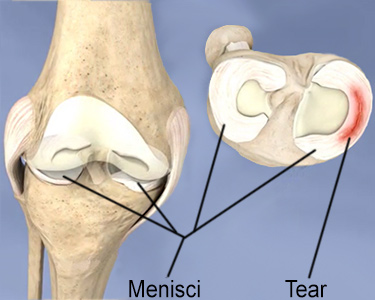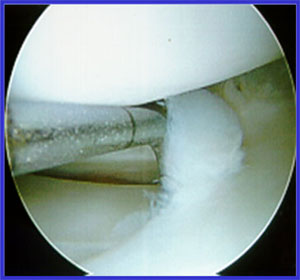Torn Meniscus
A healthy meniscus acts as a shock absorber and provides a smooth surface for your knee to glide on. A tear in the meniscus prevents your knee from rotating, causing pain and locking. Injuries to the meniscus are common, particularly among athletes.

What is the meniscus?
The meniscus is a structure in the knee joint that spans and cushions the space between the femur (thighbone) and the tibia (shinbone). There are two menisci in each knee – one on the inside (the medial meniscus) and one on the outside (the lateral meniscus).
Each is made of strong fibrocartilage and is shaped like a crescent or the letter “C.” These menisci look like suction cups that are carefully molded to the shape of the joint surfaces of the femur and tibia.

What does the meniscus do?
The shape and size of the meniscus allows it to serve several functions. When you stand up, your weight is borne evenly through your legs and down to your knees. The stress this weight places on the knee becomes even higher while walking, running, and jumping. The meniscus functions as cushion to keep the bones of the knee joint from grinding against one other and causing damage. It also transmits the load of your weight evenly across the knee joint. This load-sharing helps to prevent knee injuries and is extremely important to the function and health of the knee.
An injury to the meniscus can affect the knee’s ability to function normally. The most common type of meniscus injury is a meniscal tear.
What causes a meniscal tear?
There are two basic types of meniscal tears. A traumatic meniscal tear often happens when an athlete quickly turns the body, pivoting on the knee while the foot is planted in place on the ground. A degenerative meniscal tear is caused by wear over time, and usually affects older people.

Arthroscopic photo of a torn meniscus
Traumatic tears
Traumatic tears in the meniscus usually occur during forceful twisting of the knee and are common among players of sports such as football, basketball, and soccer, but they can occur during any activity involving knee twisting. Less often, repetitive kneeling or rising from a squatting position while lifting can lead to a tear.
Degenerative (atraumatic) tears
Degenerative or atraumatic tears, usually seen in older populations, are caused by biology and degeneration and breakdown of the meniscal structure. People with degenerative tears may have twisted their knee and accelerate the tear. However, the tear pattern in a degenerative tear is very different from that of a traumatic tear. This is important because the treatment for a degenerative tear may be very different from that of a traumatic tear.
What are the symptoms of a torn meniscus?
The key symptom of a meniscus tear is pain in the knee joint. A locking or catching sensation may also be felt in the knee, and it will often become inflamed (swollen). There may also be a feeling of weakness in the leg and a sense of the knee buckling or “giving way.” This is because displaced, fragmented tissue from a torn meniscus and swelling in the knee can affect the thigh muscles that support knee function.
Pain is usually felt in the knee above the meniscus while bearing weight on the affected knee and/or when twisting, turning, or pivoting on the knee, such as while getting in and out of a car. Walking up or down stairs may be particularly painful and may also cause increased swelling in the knee.
How is a torn meniscus diagnosed?
Your doctor will ask about your symptoms and the circumstances of your injury and conduct a physical examination. Radiological imaging studies will be ordered to confirm a diagnosis: X-rays will help rule out fractures or other bone injuries as the cause of pain, and high-resolution magnetic resonance imaging (MRI) studies will help reveal the type and location of the tear.
What type of doctor treats meniscus tears?
If you suspect a meniscus tear, it is important to be evaluated by a physiatrist, primary care sports medicine physician, or an orthopedic surgeon who specializes in sports medicine. (Find a doctor at HSS who treats meniscal tears.)
Will a meniscus tear heal on its own?
The meniscus has a limited blood supply and, therefore, has limited ability to heal on its own. Only the outer one-third of the meniscus contains blood vessels required for healing. This is known as the “red zone.” The inner two-thirds of the meniscus is avascular (meaning there is no blood supply) and is also known as the “white zone.” Most meniscus tears that affect the white zone cannot heal on their own.
Can you still walk with a torn meniscus?
Simple walking and other activities that do not require twisting, pivoting, rapid change of direction, etc., are generally well-tolerated after a meniscus tear. Tears can progress over time, but the rate of progression is generally gradual and highly variable. Pain is the guide. If a tear is being made worse, there will generally be associated symptoms of increased pain.
What happens if you leave a torn meniscus untreated?
Untreated tears can progress and become worse over time. Progressive meniscus loss can increase the risk that a person will develop degenerative knee arthritis. It is important to get a diagnosis and seek treatment early.
What is the treatment for a torn meniscus?
Nonsurgical treatments, such as anti-inflammatory medications and rehabilitation with a physical therapist may help some people with a torn meniscus. Other patients will need surgery, usually either a trimming or repair of the meniscus. Treatments may also depend on whether the tear is traumatic or degenerative.
Treatment for a meniscus tear without surgery
A non-operative physical therapy treatment program will often focus first on reducing pain and maintaining the full motion of the knee. Oral nonsteroidal anti-inflammatory medications (such as ibuprofen) may also be prescribed. After the initial injury pain has decreased and the knee motion is restored, treatment may move to muscle strengthening. Plasma-rich platelet (PRP) injections may be beneficial to some patients.
Degenerative tears may not have any separated meniscal fragments that are causing mechanical symptoms in the knee. These can often be treated without surgery through conservative treatment.
Surgical treatment for meniscal tears
Fragmented degenerative tears and most acute, traumatic tears will need meniscus surgery. Learn more from the content below or find a doctor at HSS who can diagnose and treat a torn meniscus.
Articles on treatments for a torn meniscus
Articles on related knee conditions and issues
Torn Meniscus Success Stories
Updated: 12/1/2021
Reviewed and updated by Scott Rodeo, MD